Bryobilimbia fissuriseda (Poelt) Timdal, Marthinsen & Rui
in Marthinsen & al., Biodiversity Data Journal, 7: 133, 2019. Basionym: Lecidea fissuriseda Poelt - Mitt. bot. Staatss. München, 4: 181, 1961.
Synonyms: Lecidea fissuriseda Poelt; Mycobilimbia fissuriseda (Poelt) Poelt & Hafellner
Distribution: N - TAA, Piem (TSB 34606), VA (Piervittori & Isocrono 1999).
Description: Thallus minutely squamulose, episubstratic, growing in very fine cracks of calciferous rocks. Squamules adpressed, scattered, 1-5 mm wide, finally deeply lobed, c. 500 μm thick, smooth, epruinose, pale to medium brown, paler at the usually raised margins, the lower surface dirty white to pale brown, attached by bundles of rhizines. Cortex overlain by a epinecral layer; medulla white, I-. Apothecia almost always present, lecideine, reddish brown to almost black, often crowded, sessile, 0.5-1.5 mm across, at first with a flat disc and a prominent margin, finally convex and often immarginate, epruinose. Proper exciple and hypothecium thick, medium to dark brown, of conglutinated hyphae; epithecium brown; hymenium colourless, c. 60-80 μm high; paraphyses coherent, 2-2.5 μm thick, slightly swollen and brown at apex; hypothecium and lower part of hymenium with blue-black granules reacting K+ green. Asci 8-spored, clavate, with a I+ blue tholus and an internal, darker I+ tubular structure, the external gel I+ faintly blue, Porpidia-type. Ascospores 1-celled to sometimes finally 1-septate, hyaline, ellipsoid to narrowly ellipsoid, (9-)10-15.5(-18) x 4-5 μm. Photobiont chlorococcoid. Spot tests; cortex and medulla K-, C-, KC-, P-, UV-. Chemistry: thallus apparently without lichen substances.Note: a probably circumpolar, arctic-alpine lichen found in thin fissures of calciferous rocks (calcareous schist, dolomite, much more rarely pure limestone) near and especially above treeline; certainly more widespread in the Alps.
Growth form: Crustose
Substrata: rocks
Photobiont: green algae other than Trentepohlia
Reproductive strategy: mainly sexual
Commonnes-rarity: (info)
Alpine belt: rare
Subalpine belt: very rare
Oromediterranean belt: absent
Montane belt: absent
Submediterranean belt: absent
Padanian area: absent
Humid submediterranean belt: absent
Humid mediterranean belt: absent
Dry mediterranean belt: absent

Predictive model
Herbarium samples


P.L. Nimis; Owner: Department of Life Sciences, University of Trieste
Herbarium: TSB (33088)
2001/12/10


P.L. Nimis; Owner: Department of Life Sciences, University of Trieste
Herbarium: TSB (33088)
2001/12/10
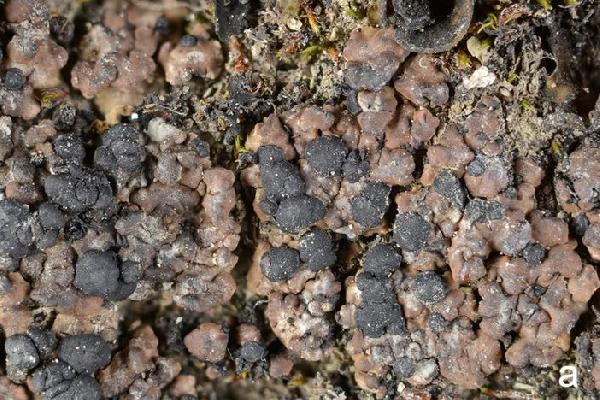
Source: Evankow, A.M., Yin, A., Zulfiqar, R. et al. Psora mediterranea (Lecanorales, Psoraceae), a new lichen species from Europe, including a new concept for P. himalayana and a revised key to the European species. Mycol Progress 24, 26 (2025). https://doi.org/10.1007/s11557-025-02045-8 - CC BY 4.0
Norway
Norway, O-L-11605, Photo: E. Timdal
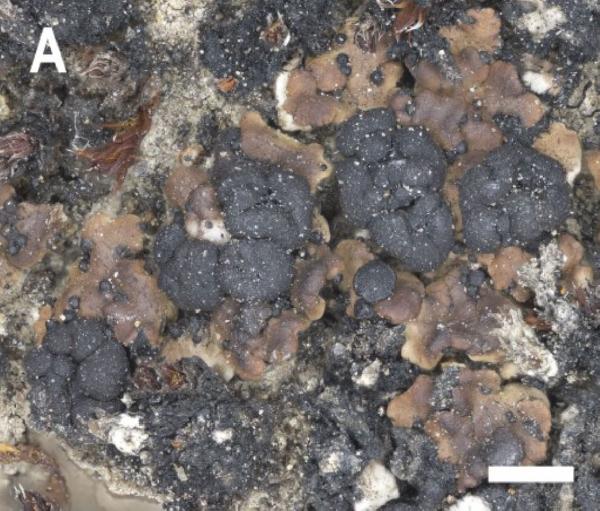
Source: Zhurbenko, M. P. & Timdal, E. 2025. Bryobilimbia fissuriseda new to Asia. Graphis Scripta 37 (2): 7–9. Oslo. ISSN 2002-4495. - CC BY-4.0
LE F-355142b Scale: 1 mm
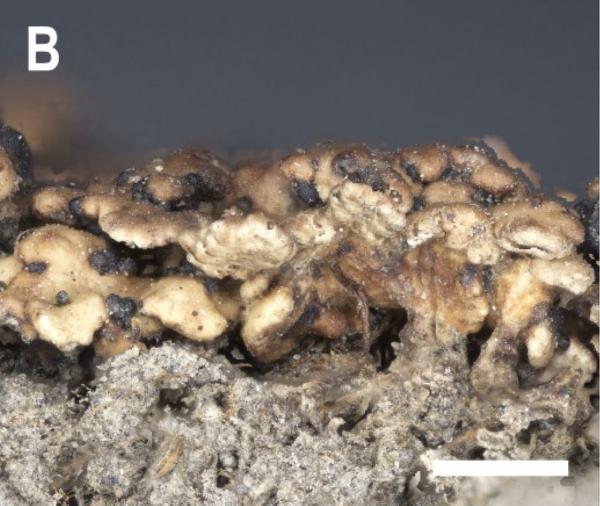
Source: Zhurbenko, M. P. & Timdal, E. 2025. Bryobilimbia fissuriseda new to Asia. Graphis Scripta 37 (2): 7–9. Oslo. ISSN 2002-4495. - CC BY-4.0
LE F-355142b Scale: 1 mm
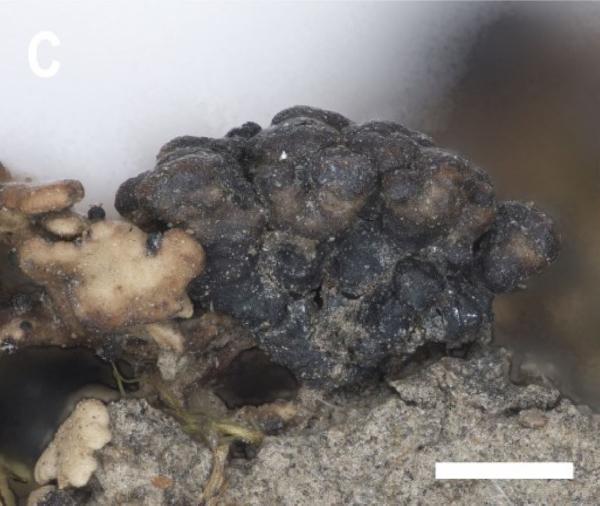
Source: Zhurbenko, M. P. & Timdal, E. 2025. Bryobilimbia fissuriseda new to Asia. Graphis Scripta 37 (2): 7–9. Oslo. ISSN 2002-4495. - CC BY-4.0
LE F-355142b Scale: 1 mm
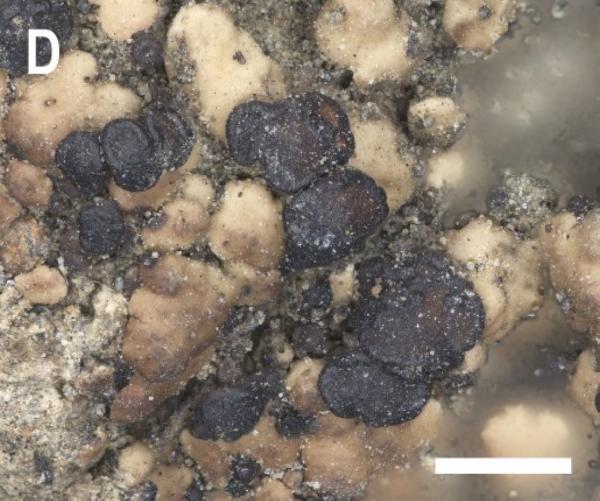
Source: Zhurbenko, M. P. & Timdal, E. 2025. Bryobilimbia fissuriseda new to Asia. Graphis Scripta 37 (2): 7–9. Oslo. ISSN 2002-4495. - CC BY-4.0
LE F-355142b Scale: 1 mm
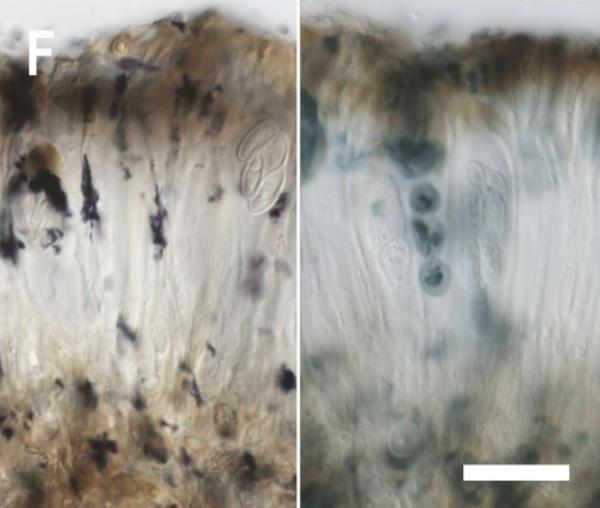
Source: Zhurbenko, M. P. & Timdal, E. 2025. Bryobilimbia fissuriseda new to Asia. Graphis Scripta 37 (2): 7–9. Oslo. ISSN 2002-4495. - CC BY-4.0
LE F-355142b epihymenuim and hymenium in cross
section, in water (left) and K (right). Note the colour change of the blotchy/coralloid inclusions/granules from
dark purple to dull blue or dark blue in K Scale: 20 μm.
Growth form: Crustose
Substrata: rocks
Photobiont: green algae other than Trentepohlia
Reproductive strategy: mainly sexual
Commonnes-rarity: (info)
Alpine belt: rare
Subalpine belt: very rare
Oromediterranean belt: absent
Montane belt: absent
Submediterranean belt: absent
Padanian area: absent
Humid submediterranean belt: absent
Humid mediterranean belt: absent
Dry mediterranean belt: absent

Predictive model
| Herbarium samples |


P.L. Nimis; Owner: Department of Life Sciences, University of Trieste
Herbarium: TSB (33088)
2001/12/10


P.L. Nimis; Owner: Department of Life Sciences, University of Trieste
Herbarium: TSB (33088)
2001/12/10

Source: Evankow, A.M., Yin, A., Zulfiqar, R. et al. Psora mediterranea (Lecanorales, Psoraceae), a new lichen species from Europe, including a new concept for P. himalayana and a revised key to the European species. Mycol Progress 24, 26 (2025). https://doi.org/10.1007/s11557-025-02045-8 - CC BY 4.0
Norway
Norway, O-L-11605, Photo: E. Timdal

Source: Zhurbenko, M. P. & Timdal, E. 2025. Bryobilimbia fissuriseda new to Asia. Graphis Scripta 37 (2): 7–9. Oslo. ISSN 2002-4495. - CC BY-4.0
LE F-355142b Scale: 1 mm

Source: Zhurbenko, M. P. & Timdal, E. 2025. Bryobilimbia fissuriseda new to Asia. Graphis Scripta 37 (2): 7–9. Oslo. ISSN 2002-4495. - CC BY-4.0
LE F-355142b Scale: 1 mm

Source: Zhurbenko, M. P. & Timdal, E. 2025. Bryobilimbia fissuriseda new to Asia. Graphis Scripta 37 (2): 7–9. Oslo. ISSN 2002-4495. - CC BY-4.0
LE F-355142b Scale: 1 mm

Source: Zhurbenko, M. P. & Timdal, E. 2025. Bryobilimbia fissuriseda new to Asia. Graphis Scripta 37 (2): 7–9. Oslo. ISSN 2002-4495. - CC BY-4.0
LE F-355142b Scale: 1 mm

 INDEX FUNGORUM
INDEX FUNGORUM
 GBIF
GBIF
 DOLICHENS
DOLICHENS





